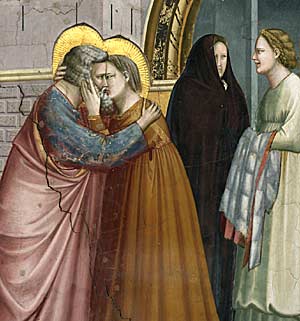
 |
| Detail of scene in which Joachim comes home and embraces Anna at the Golden Door |
The entire upper register
of the right-hand (south) wall is occupied by six scenes devoted to the
Virgin's parents. None of the four Gospels recounts their story, which
has few iconographic precedents before or during Giotto's lifetime. (It
is absent, for instance, from the vast collection of scenes in Duccio's
Maestà.)
Joachim, old and childless, is expelled from the Temple because sterility
was considered dishonourable. Taking refuge among some shepherds, he carries
out sacrifices that are accepted by God (see the hand of God above the
altar built by Joachim in the desert), and in a dream sees an angel who
tells him to go to Jerusalem. Meanwhile Anna is also comforted by the
angel. Outside the Golden Gate in Jerusalem, there is a touching meeting
between them, represented in the fresco by a chaste and moving kiss.
Sources
The chief literary source is the Golden Legend, an extremely popular work
written in the later thirteenth century by Jacopo da Varagine, full of
narrative details which were soon adopted by painters.
In the order of the calendar year, Jacopo tells the lives and miracles
of the saints and records facts concerning the principal religious festivals.
He draws on a number of sources: the Apocryphal Gospels, Early Christian
writers, the Doctors of the Church, and popular traditions. For the story
of Joachim and Anna, Jacopo depends on the Apocryphal Protevangelium of
James (which is also referred to in the introduction to St. Jerome's Vulgate)
and on the so-called Gospel of the Birth of the Virgin. The first of these
circulated widely in the Middle Ages and left many traces in religious
iconography, especially in depictions of the birth of the Virgin and the
infancy of Christ. Giotto may well have known the text himself. Another
possible literary source is the thirteenth-century 'Speculum Historiae'
by Vincent of Beauvais, which recounts the story of the birth of the Virgin.
Giotto scrupulously follows the story as recounted in the Golden Legend,
but with some modifications, inspired by the Protevangelium of James:
he inverts the order of Anna's vision and Joachim's dream and adds the
episode of Joachim's sacrifice.
Iconography
An iconographic hint of things to come is provided by the possibility
of identifying the angel who visits Joachim and Anna with the Archangel
Gabriel in the Annunciation scene on the east wall.
The great simplicity of the architectural settings allows Giotto to create
a number of 'spatial cells' that will reappear in the cycle. For example,
Anna's house appears again as the setting of the Birth of the Virgin on
the opposite wall. The contrast between Anna's solitude in prayer and
the happy confusion of the birth emphasises the different psychological
implications of the two scenes in the same setting.
Finally, a number of references to real architecture should be noted:
the Temple from which Joachim is expelled suggests the choir enclosures
of Romanesque basilicas, with marble screens enclosing a baldacchino on
spiraI columns; and according to some scholars, the Golden Gate is based
on Roman remains in Rimini, particularly the Arch of Augustus, built into
the medieval circuit of crenellated walls.